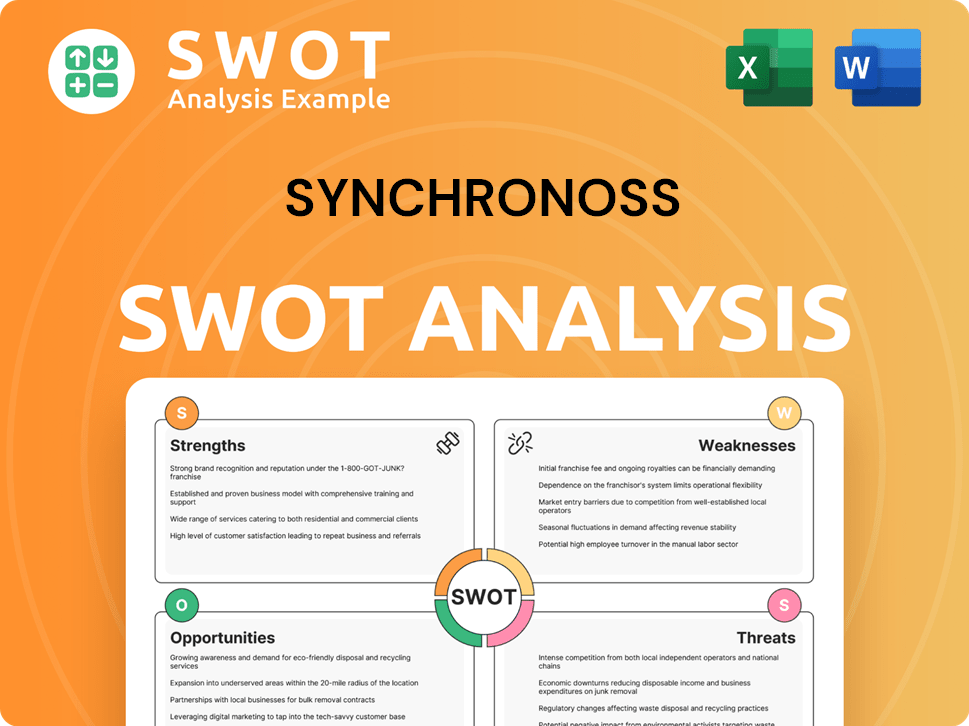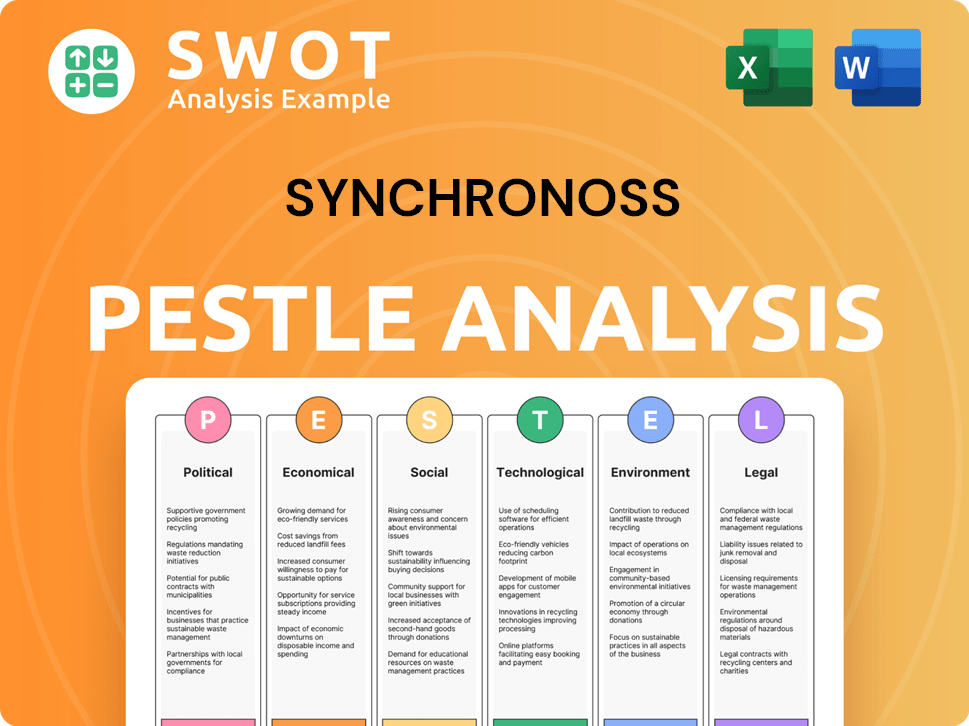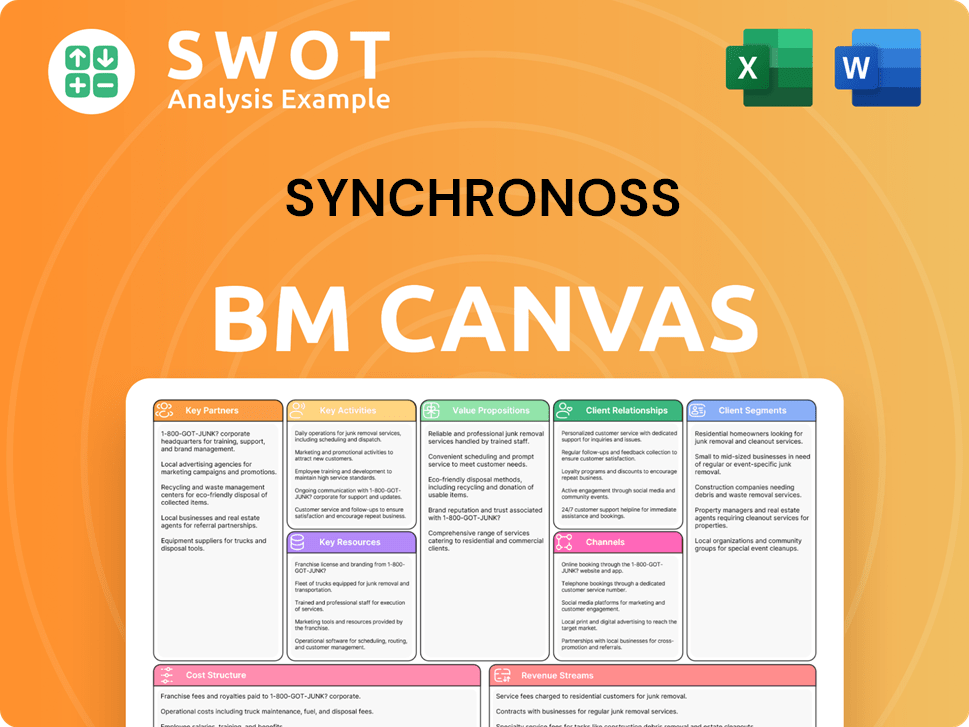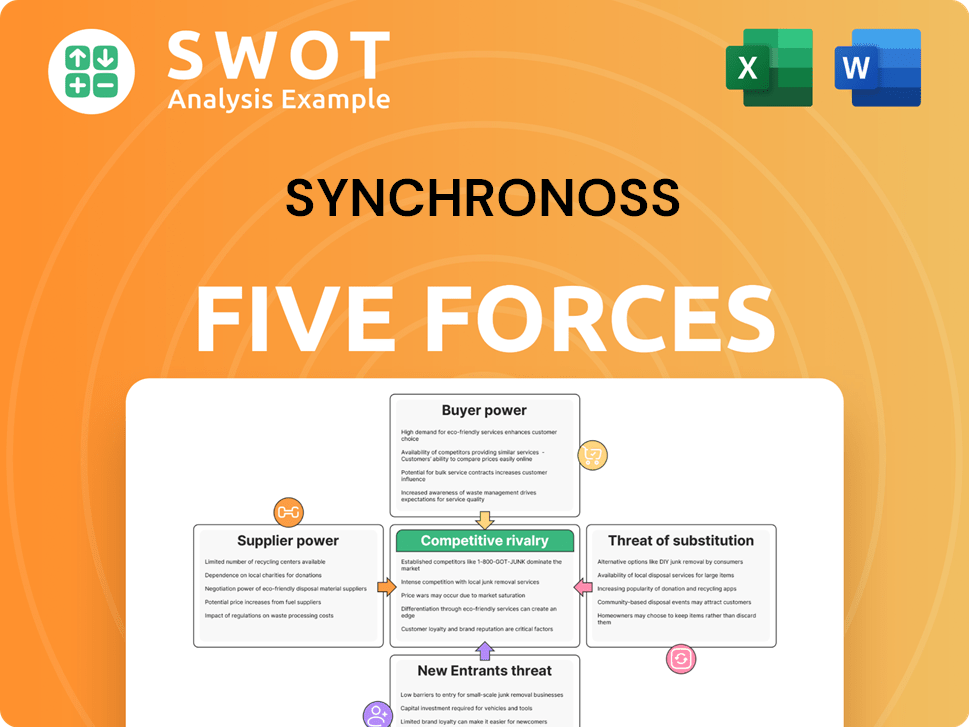Synchronoss Bundle
Can Synchronoss Technologies Thrive in Today's Telecom Arena?
Synchronoss Technologies, Inc. has carved a niche in the telecommunications sector by providing cloud, messaging, and digital transformation platforms. Founded in 1997, the company initially focused on provisioning software but has since expanded its offerings to meet the evolving needs of a digital world. This strategic shift has positioned Synchronoss as a key enabler for service providers globally.

This article provides a detailed Synchronoss SWOT Analysis and dives deep into the Synchronoss competitive landscape, examining its key rivals and assessing its Synchronoss market analysis. We'll explore the Synchronoss competitors, evaluating their strengths and weaknesses to understand how Synchronoss positions itself within the Synchronoss industry. Understanding the Synchronoss business strategy is crucial for investors and stakeholders alike, especially when considering Synchronoss financial performance.
Where Does Synchronoss’ Stand in the Current Market?
Synchronoss Technologies carves out a specific niche within the telecommunications software and services sector. It primarily serves telecommunications companies and other businesses with its cloud, messaging, and digital transformation products. While precise market share data for its specialized offerings isn't always available in broad market analyses, Synchronoss is recognized for its strong presence in providing personal cloud solutions for mobile operators and its expertise in advanced messaging platforms. The company's core offerings include its Personal Cloud platform, Advanced Messaging platform (including Rich Communication Services or RCS), and Digital Journey Platform for customer onboarding and activation.
The company's global presence includes a significant footprint in North America, Europe, and parts of Asia, catering to a diverse customer base of tier-one mobile network operators and other service providers. Synchronoss has evolved from a provisioning software vendor to a more diversified digital services provider, emphasizing recurring revenue streams from its cloud and messaging platforms. This shift aligns with the industry's trend towards digital transformation and the monetization of digital content and services by telcos. As of late 2024 and early 2025, Synchronoss is focused on achieving profitability and sustainable growth, often highlighting its recurring revenue base and strategic partnerships with major carriers. Its scale, though not comparable to industry giants like Ericsson or Nokia, is substantial within its specific solution areas, and it continues to invest in enhancing its platforms to maintain relevance and competitive edge.
Synchronoss's position is particularly strong in enabling operators to offer branded cloud storage and next-generation messaging experiences to their subscribers. The company's ability to provide these services positions it well within the Synchronoss competitive landscape, allowing it to compete effectively in a market driven by digital transformation and the increasing demand for cloud-based solutions.
Synchronoss focuses on providing cloud, messaging, and digital transformation solutions. Its core operations revolve around its Personal Cloud platform, Advanced Messaging platform, and Digital Journey Platform. These platforms enable mobile operators to offer branded cloud storage and advanced messaging services to their subscribers.
The value proposition of Synchronoss lies in its ability to help telecommunications companies enhance their service offerings and customer engagement. By providing cloud storage and advanced messaging capabilities, Synchronoss enables operators to improve customer retention and generate additional revenue streams. This is a key aspect of the Growth Strategy of Synchronoss.
Synchronoss primarily targets telecommunications companies, including mobile network operators and other service providers. Its focus is on enabling these companies to offer enhanced digital services to their subscribers, driving customer loyalty and revenue growth. The company's solutions are tailored to meet the specific needs of the telecom industry.
Synchronoss has a global presence with significant operations in North America, Europe, and Asia. This broad geographic reach allows the company to serve a diverse customer base and capitalize on market opportunities in various regions. This global footprint supports its growth strategy and market penetration efforts.
Synchronoss's key strengths include its specialized focus on the telecom sector, its strong presence in cloud and messaging solutions, and its ability to provide recurring revenue streams. These strengths position the company well within the Synchronoss industry. The company's strategic partnerships and focus on profitability also contribute to its competitive advantage.
- Strong presence in personal cloud solutions for mobile operators.
- Expertise in advanced messaging platforms, including RCS.
- Focus on recurring revenue through cloud and messaging services.
- Global presence with a diverse customer base.
Synchronoss SWOT Analysis
- Complete SWOT Breakdown
- Fully Customizable
- Editable in Excel & Word
- Professional Formatting
- Investor-Ready Format

Who Are the Main Competitors Challenging Synchronoss?
The Synchronoss competitive landscape is multifaceted, encompassing direct and indirect rivals across its cloud, messaging, and digital transformation segments. Understanding the Synchronoss competitors is crucial for investors and strategists assessing the company's position within the telecommunications and digital services market. A thorough Synchronoss market analysis reveals the strengths and weaknesses of key players and the dynamics shaping the industry.
Synchronoss's business strategy is influenced by the competitive pressures from various companies. The company's financial performance is directly impacted by its ability to differentiate itself and capture market share. The Synchronoss industry is constantly evolving, with new technologies and business models emerging, making it essential to monitor the competitive landscape closely.
In the personal cloud space, Synchronoss faces competition from white-label cloud solution providers. Indirectly, it competes with large consumer cloud services like Google Drive, Apple iCloud, and Dropbox. These consumer services, which mobile operators could consider as alternatives or integrate into their offerings, present a challenge. Synchronoss differentiates itself by providing carrier-grade, white-label solutions tailored for telecommunication companies, enabling them to offer branded cloud services to their subscribers.
Direct competitors include white-label cloud solution providers, offering similar services to telecommunications companies. Indirect competitors are large consumer cloud services like Google Drive and Apple iCloud.
Synchronoss competes with technology providers like Mavenir and Infobip, which offer RCS platforms. These companies focus on enabling next-generation messaging experiences for mobile operators and enterprises.
Synchronoss faces competition from software vendors, system integrators, and internal IT departments of large telecommunication companies. Companies like Amdocs and CSG Systems International are key rivals.
Mergers and alliances among BSS/OSS vendors and partnerships between cloud providers and telecommunication equipment manufacturers reshape the competitive landscape. Synchronoss must remain agile and innovative to adapt.
Synchronoss competes for market share in various segments, including cloud solutions, advanced messaging, and digital transformation platforms. The company's ability to secure and retain customers is a key indicator of its competitive success.
Synchronoss positions itself as a provider of carrier-grade, white-label solutions, focusing on the needs of telecommunication companies. This strategy helps it to differentiate from consumer-focused cloud services and other competitors.
For advanced messaging, particularly RCS, Synchronoss competes with technology providers such as Mavenir and Infobip. These companies also offer platforms for enabling next-generation messaging experiences for mobile operators and enterprises. The competition here often revolves around platform robustness, ease of integration, and the ability to drive subscriber adoption of new messaging features. In the broader digital transformation and customer experience platforms segment, Synchronoss faces competition from a wide array of software vendors, system integrators, and even internal IT departments of large telecommunication companies. Companies like Amdocs, CSG Systems International, and various BSS/OSS providers offer solutions that overlap with Synchronoss's digital journey platforms, particularly in areas of customer onboarding, activation, and service management. Emerging players focusing on AI-driven customer experience and automation also present a growing competitive force. Mergers and alliances, such as consolidation among BSS/OSS vendors or partnerships between cloud providers and telecommunication equipment manufacturers, continually reshape the competitive dynamics, requiring Synchronoss to remain agile and innovative. For further insights into the company's market positioning and strategy, consider reading more about the Target Market of Synchronoss.
Several factors determine the success of Synchronoss in the competitive landscape. These include technological innovation, strategic partnerships, and the ability to meet the evolving needs of telecommunication companies.
- Technological Innovation: Continuous development of new features and capabilities.
- Strategic Partnerships: Collaborations with network operators and other technology providers.
- Customer Relationships: Building and maintaining strong relationships with telecommunication companies.
- Market Trends: Adapting to changes in the telecommunications industry, such as the growth of 5G and the demand for digital transformation solutions.
Synchronoss PESTLE Analysis
- Covers All 6 PESTLE Categories
- No Research Needed – Save Hours of Work
- Built by Experts, Trusted by Consultants
- Instant Download, Ready to Use
- 100% Editable, Fully Customizable

What Gives Synchronoss a Competitive Edge Over Its Rivals?
Understanding the Synchronoss competitive landscape requires a close look at its strengths. The company has carved out a niche by focusing on telecommunications software and services. Its long-standing relationships with major mobile network operators are a key differentiator, allowing for deeply integrated solutions.
Synchronoss market analysis reveals a focus on carrier-grade platforms, particularly for personal cloud and advanced messaging. This focus allows it to handle the scale, security, and reliability demands of large subscriber bases. This is a significant advantage over competitors that may be more consumer-focused.
Synchronoss business strategy leverages proprietary technologies in cloud synchronization, data management, and messaging protocols. The white-label model further enhances its competitive edge. The company's ability to adapt to evolving industry standards, such as RCS messaging, demonstrates its commitment to staying ahead of technological curves.
Synchronoss competitive advantages stem from its established relationships with tier-one mobile network operators globally. These partnerships facilitate the development and deployment of highly integrated solutions. This deep integration with existing telecom infrastructure is a significant competitive edge.
The company's proprietary technologies in cloud synchronization, data management, and messaging protocols are key. Its Personal Cloud platform offers unique features for seamless content transfer and storage across devices. This technological advantage is crucial for reducing churn and increasing customer engagement.
Synchronoss competitors face a challenge in replicating its white-label model. This allows operators to offer services under their own brand. This approach fosters customer loyalty and provides a unique value proposition, which is difficult for generic competitors to replicate.
Synchronoss industry leadership is supported by its ability to innovate and adapt to evolving industry standards. Its commitment to staying ahead of technological curves, such as RCS messaging, is important. Continuous investment in R&D is essential to maintain this advantage.
Synchronoss financial performance is influenced by its ability to leverage its competitive advantages in the market. The company's go-to-market strategy emphasizes its proven track record with major carriers. The revenue-generating potential of its digital platforms is a key focus.
- Strong carrier relationships provide a stable customer base.
- Proprietary technology offers differentiation in a competitive market.
- White-label solutions enhance customer loyalty.
- Adaptability to industry standards ensures long-term relevance.
Synchronoss Business Model Canvas
- Complete 9-Block Business Model Canvas
- Effortlessly Communicate Your Business Strategy
- Investor-Ready BMC Format
- 100% Editable and Customizable
- Clear and Structured Layout

What Industry Trends Are Reshaping Synchronoss’s Competitive Landscape?
The telecommunications industry is experiencing a period of significant transformation, creating both challenges and opportunities for companies like Synchronoss. The ongoing deployment of 5G networks and the increasing demand for advanced digital experiences are key drivers of this change. Understanding the Synchronoss competitive landscape and the broader Synchronoss industry trends is crucial for assessing the company's future prospects.
Key risks include intense competition from established players and the need for continuous innovation. However, opportunities exist in emerging markets and through the expansion of services like RCS messaging. The company's ability to adapt its Synchronoss business strategy and leverage emerging technologies will determine its success in the evolving market.
The telecommunications sector is currently shaped by the rollout of 5G, which promises higher bandwidth and lower latency, thereby enabling new digital services. There's a growing emphasis on personalized digital experiences and self-service options, pushing telcos to invest in digital transformation. The expansion of Rich Communication Services (RCS) messaging presents an opportunity as it offers a richer experience than traditional SMS.
Intense competition from major cloud providers and software vendors poses a significant challenge. The need for constant innovation to meet evolving consumer expectations and technological advancements is critical. Regulatory changes, particularly those related to data privacy and security, require continuous adaptation. Economic conditions and potential declines in ARPU may pressure telcos to reduce IT spending, affecting sales cycles.
Significant growth opportunities are present in emerging markets where digital adoption is accelerating. Expanding services like RCS messaging globally can provide new avenues for revenue. The increasing need for digital identity and fraud prevention could allow companies to leverage their expertise in secure digital interactions. Strategic partnerships with new operators can facilitate expansion and address specific regional needs.
The Synchronoss competitive landscape will evolve based on its ability to integrate AI and machine learning for enhanced personalization and automation. Expanding offerings to address the digital ecosystem of its telecommunication clients is crucial. The company must focus on innovation and strategic partnerships to maintain and improve its market position. A thorough Synchronoss market analysis is essential for navigating these changes.
The Synchronoss competitors include established cloud providers and software vendors. The company must differentiate itself through innovation and strategic partnerships. Factors like regulatory compliance and economic conditions will significantly impact the company's Synchronoss financial performance.
- Focus on 5G-enabled applications and personalized experiences.
- Adapt to changing regulatory landscapes, particularly regarding data privacy.
- Explore strategic partnerships to expand market reach and service offerings.
- Invest in AI and machine learning to enhance platform capabilities.
Synchronoss Porter's Five Forces Analysis
- Covers All 5 Competitive Forces in Detail
- Structured for Consultants, Students, and Founders
- 100% Editable in Microsoft Word & Excel
- Instant Digital Download – Use Immediately
- Compatible with Mac & PC – Fully Unlocked

Related Blogs
- What are Mission Vision & Core Values of Synchronoss Company?
- What is Growth Strategy and Future Prospects of Synchronoss Company?
- How Does Synchronoss Company Work?
- What is Sales and Marketing Strategy of Synchronoss Company?
- What is Brief History of Synchronoss Company?
- Who Owns Synchronoss Company?
- What is Customer Demographics and Target Market of Synchronoss Company?
Disclaimer
All information, articles, and product details provided on this website are for general informational and educational purposes only. We do not claim any ownership over, nor do we intend to infringe upon, any trademarks, copyrights, logos, brand names, or other intellectual property mentioned or depicted on this site. Such intellectual property remains the property of its respective owners, and any references here are made solely for identification or informational purposes, without implying any affiliation, endorsement, or partnership.
We make no representations or warranties, express or implied, regarding the accuracy, completeness, or suitability of any content or products presented. Nothing on this website should be construed as legal, tax, investment, financial, medical, or other professional advice. In addition, no part of this site—including articles or product references—constitutes a solicitation, recommendation, endorsement, advertisement, or offer to buy or sell any securities, franchises, or other financial instruments, particularly in jurisdictions where such activity would be unlawful.
All content is of a general nature and may not address the specific circumstances of any individual or entity. It is not a substitute for professional advice or services. Any actions you take based on the information provided here are strictly at your own risk. You accept full responsibility for any decisions or outcomes arising from your use of this website and agree to release us from any liability in connection with your use of, or reliance upon, the content or products found herein.